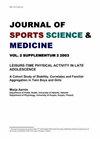Technical Skills Influences on Front Crawl Tumble Turn Performance in Elite Female Swimmers.
IF 2.4
2区 医学
Q2 SPORT SCIENCES
引用次数: 0
Abstract
The objective of this research was to compare technical skills composed of kinematic and kinetic variables in the complex motor task of a tumble turn between 9 elites and 9 sub-elite female swimmers. The best tumble turn among three attempts was analyzed using a three-dimensional underwater protocol. A total of 37 kinematic variables were derived from a Direct Linear Transformation algorithm for 3D reconstruction, and 16 kinetic variables measured by a piezoelectric 3D force platform. Data were analyzed by Student's t-test and effect size statistics. Pearson correlations were applied to the data of the eighteen swimmers to relate the association of 53 kinematic, kinetic variables to the performance of the tumble-turn (3 meters Round Trip Time, 3m RTT). The approach and the whole turn times were faster for elite swimmers compared to sub elites (1.09±0.06 vs. 1.23±0.08 sec, and 2.89±0.07 vs. 3.15±0.11 sec.), as well as the horizontal speeds of the swimmers' head 1 m before the rotation (1.73±0.13 vs. 1.57±0.13 m/sec.), at the end of the push-off on force platform (2.55±0.15 vs. 2.31±0.22 m/sec.) and 3 m after the wall (2.01±0.19 vs. 1.68±0.12 m/sec.). Large differences (|d| > 0.8) in favor of the elite swimmers were identified for the index of upper body extension at the beginning of the push-off, the lower limb extension index at the end of push-off, and among the kinetic variables, the horizontal impulse and lateralization of the push-off. Correlations for the whole group revealed a moderate to strong relationship between 6 body extension indices and 3mRTT performance. For the kinetic variables, the correlations indicated the fastest swimmers in 3mRTT showed large lateral impulse during placement (r=0.46), maximum horizontal force during the push-off (r=0.45) and lateralization of the push-off (r=0.44) (all p<0.05). Elite female swimmers had higher approach and push-off speeds, were more streamlined through the contact, and showed a higher horizontal impulse and lateralization of the push-off, than their sub-elite counterparts.技术技能对优秀女子游泳运动员前爬泳、翻滚转身成绩的影响
摘要本研究的目的是比较9名优秀和9名次优秀的女子游泳运动员在翻滚转身复杂运动任务中的运动学和动力学变量组成的技术技能。利用三维水下协议,分析了三种尝试中的最佳翻滚动作。采用直接线性变换(Direct Linear Transformation)算法进行三维重构,得到了37个运动学变量,并利用压电式三维力平台测量了16个动力学变量。数据分析采用学生t检验和效应量统计。Pearson相关性应用于18名游泳运动员的数据,将53个运动学和动力学变量与翻滚转身(3米往返时间,3米RTT)的表现联系起来。优秀运动员的入水和整个转身时间(1.09±0.06比1.23±0.08秒,2.89±0.07比3.15±0.11秒)均快于次优秀运动员,旋转前1米的头部水平速度(1.73±0.13比1.57±0.13米/秒)、力台蹬水结束时的头部水平速度(2.55±0.15比2.31±0.22米/秒)和墙后3米的头部水平速度(2.01±0.19比1.68±0.12米/秒)也快于次优秀运动员。在蹬水开始时的上肢伸展指数和蹬水结束时的下肢伸展指数,以及蹬水的水平冲量和侧边度等动力学变量上,均存在较大差异(|d| > 0.8),有利于优秀游泳运动员。整个组的相关性显示6个身体伸展指数与3mRTT表现之间存在中等到强烈的关系。在动力学变量方面,3mRTT中最快的运动员在入位时表现出较大的侧向冲量(r=0.46),在推离时表现出最大的水平力(r=0.45)和推离侧化(r=0.44)(均p<0.05)。优秀的女游泳运动员比次优秀的对手有更高的接近和蹬水速度,在接触过程中更流畅,并且表现出更高的水平冲量和蹬水的横向化。
本文章由计算机程序翻译,如有差异,请以英文原文为准。
求助全文
约1分钟内获得全文
求助全文
来源期刊
CiteScore
5.60
自引率
6.20%
发文量
56
审稿时长
4-8 weeks
期刊介绍:
The Journal of Sports Science and Medicine (JSSM) is a non-profit making scientific electronic journal, publishing research and review articles, together with case studies, in the fields of sports medicine and the exercise sciences. JSSM is published quarterly in March, June, September and December. JSSM also publishes editorials, a "letter to the editor" section, abstracts from international and national congresses, panel meetings, conferences and symposia, and can function as an open discussion forum on significant issues of current interest.

 求助内容:
求助内容: 应助结果提醒方式:
应助结果提醒方式:


